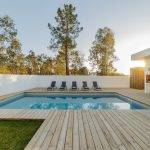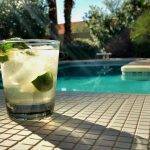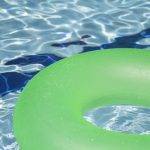There are five chemical levels that every pool owner needs to keep track of:
- FC – Free Chlorine – A sanitizer which keeps your pool water safe and free of germs. Chlorine must be constantly replenished. (level depends on CYA)
- pH – Acidity/Basicity – Needs to be kept in balance to prevent irritation and protect the pool equipment. (7.2 to 8.0)
- TA – Total Alkalinity – Appropriate levels help keep the pH in balance. High levels can cause pH to rise. (50 to 90ppm, sometimes higher)
- CH – Calcium Hardness – Appropriate levels help prevent plaster damage. High levels can cause calcium scaling. (fiberglass or plaster pool 250 to 650ppm, vinyl pool 50-650ppm)
- CYA – Cyanuric Acid – Protects chlorine from sunlight and determines the required FC level. (non-saltwater pools 30 to 60ppm, saltwater pools 60 to 90ppm, indoor pools 0 to 20ppm)
Here are four other chemical levels that come up frequently enough that you should at least know what they are:
- CC – Combined Chloramines – CC levels of 1.0ppm or greater indicates a problem.
- Salt – Required with a SWG (salt water chlorine generator), otherwise an optional enhancement. See Salt for more information.
- Borates – An optional enhancement. See Borates for more information.
- Phosphates – Doesn’t matter, despite pool stores claiming otherwise. Proper maintenance of your FC makes phosphate levels irrelevant.
All nine are described in more detail below.
FC- Free Chlorine
Maintaining an appropriate FC level is the most important part of keeping your water in balance. It is important that you do not allow FC to get too low, or you run the risk of getting algae. If FC gets down to zero and you have algae, the pool is not safe to swim in.
Your FC level shows the amount of disinfecting chlorine available (active plus reserve) to keep your pool sanitary. FC should be tested, and chlorine added daily. If you have an automatic feeder or SWG, you can test it every couple of days. FC is consumed by sunlight, and by breaking down organic material in your pool. The level of FC you need to maintain depends on your CYA level and how much you use the pool. See the Chlorine / CYA Chart for guidelines on the appropriate FC level to maintain based on your CYA level.
Recommended ways to raise FC include: household bleach, liquid chlorine, and salt water chlorine generators (SWG). Avoid “splashless” bleach or any bleach with fragrance or additives.
CC- Combined Chloramines
Combined chloramines (also known as combined chlorine) is an intermediate breakdown product created in the process of sanitizing the pool. CC causes the “chlorine” smell many people associate with chlorine pools. If CC is 1.0ppm or higher, you should SLAM your pool. CC indicates that there is something in the water that the FC is in the process of breaking down. In an outdoor pool, CC will normally stay at or near zero as long as you maintain an appropriate FC level and the pool gets some direct sunlight.
Potassium monopersulfate (a common non-chlorine shock) will show up on FAS-DPD chlorine tests as CC. There is a special reagent you can get to neutralize the potassium monopersulfate so you can get a true CC reading.
pH – Acidity/Basicity
pH indicates how acidic or basic the water is. PH should be tested daily at first. Once you gain experience with your pool, less frequent monitoring may be appropriate, depending on your pool’s typical rate of PH change. A PH level of 7.6 to 7.8 is ideal, but anything between 7.2 and 8.0 is acceptable.
pH levels below 7.2 tend to make eyes sting or burn. pH below 6.8 can cause damage to metal parts, particularly pool heaters with copper heat exchange coils. High pH can lead to calcium scaling.
Many pools will drift up towards higher pH over time. This is particularly true for fresh plaster (particularly in the first month and continuing for perhaps a year) or when TA is high and the water is being aerated (because of a spa, waterfall, fountain, SWG, rain, kids splashing in the pool, etc).
To lower pH use either muriatic acid. To raise pH use borax or soda ash.
TA – Total Alkalinity
Total alkalinity indicates the water’s ability to buffer pH changes. Buffering means you need to use a larger quantity of a chemical to change the pH. At low TA levels, the pH tends to swing around wildly. At high TA levels, the pH tends to drift up.
You can raise TA with baking soda. It is often best to make large TA adjustments in small steps, testing the water after each one, as adding large quantities of baking soda can raise the pH too high. If you need to lower your TA level, see How To Lower Total Alkalinity.
CH – Calcium Hardness
Calcium hardness indicates the amount of calcium in the water. Over time, water with low calcium levels will tend to dissolve calcium out of plaster, pebble, tile, stone, concrete, and to some extent fiberglass surfaces. You can prevent this from happening by keeping the water saturated with calcium. In a vinyl liner pool there is no need for calcium, though high levels >650 ppm can still cause problems. A plaster pool or fiberglass pool should attempt to keep their CH between 250 and 650ppm. If you have a spa you might want to keep CH at at least 100 to 150 to reduce foaming.
You increase CH with calcium chloride or calcium chloride dihydrate, which is sold by hardware stores as “deicer” and by pool stores as “calcium/CH increaser.” You lower calcium by replacing water or using a reverse osmosis water treatment.
CYA – Cyanuric Acid
Cyanuric acid, often called stabilizer or conditioner, both protects FC from sunlight and lowers the effective strength of the FC (by holding some of the FC in reserve). The higher your CYA level, the more FC you need to use to get the same effect. It is important to know your CYA level so you can figure out what FC level to aim for. If you don’t have a SWG, CYA is typically kept between 30 and 60ppm. If you have a SWG, CYA is typically kept between 60 and 90ppm.
CYA can be raised with cyanuric acid. Cyanuric acid is sold under a variety of names, including Stabilizer, Conditioner, Instant Pool Water Conditioner, Stabilizer 100, Stabilizer & Conditioner, etc. Instant Pool Water Conditioner is a liquid product which is significantly more expensive than the other forms.
Solid/granular cyanuric acid (CYA) should be placed in a sock and the sock put in the skimmer basket or suspended in front of a pool return. After adding CYA you should leave the pump running for 24 hours and not backwash/clean the filter for a week. Squeezing the sock periodically will help it to dissolve faster. Test and dose chemicals in your pool assuming the amount of CYA added is in the pool according to Pool Math. CYA can be tested the day after it is fully dissolved from the sock.
In nearly all cases the best way to lower CYA is to replace water. If replacement water is extremely expensive you might want to look into a reverse osmosis water treatment.
Salt
Salt is required with a SWG. Salt can also be added to the water to enhance the subjective feel of the water. For a SWG, check the manual for the correct salt level for your unit. This level will typically around 3,000, but different models vary. For improved water feel without a SWG, try levels around 2,000ppm. These levels are less then one tenth of the salt level in ocean water, which has around 35,000 ppm of salt. People vary in their ability to taste low levels of salt. A few people can taste salt levels as low as 1,000ppm, others not until 3,500ppm or more.
Salt can be added using solar salt, sold for use in water softeners (sodium chloride). You want the kind that is 99.4% pure or better and which doesn’t have any rust inhibitor or other additives. Crystals are fine. Pellets will work but dissolve slightly more slowly. Pool store salt generally costs more and is more finely ground, but pellets dissolve quickly enough so that isn’t really any advantage.
Borate
Borates are an optional enhancement that helps control pH drift and provides various subjective water quality/feel improvements. If you are not intentionally using borates there is no need to test for them. When using borates, the recommended level is between 30 and 50 ppm.
Phosphate
Phosphates are sometimes removed from the pool as a way of keeping algae in check. Chlorine alone is sufficient to keep algae in check, even at very high phosphate levels. Since phosphate remover can be rather expensive and annoying to use, it doesn’t make much sense to use phosphate remover except in rare and unusual situations.
© TroubleFreePool.com 2014





